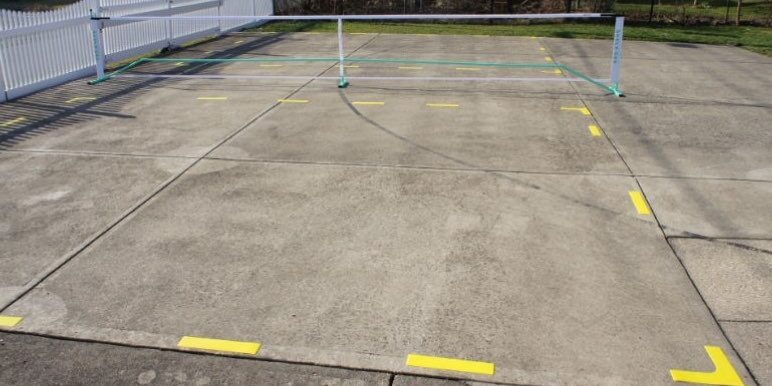High-grade Pickleball Court Construction for each Level of Play
High-grade Pickleball Court Construction for each Level of Play
Blog Article
Lasting Practices in Pickleball Court Construction You Should Know
As the popularity of pickleball proceeds to rise, so too does the demand for lasting techniques in court building and construction. This approach not just addresses environmental concerns however likewise improves the durability and performance of the courts. From picking environmentally friendly materials to implementing reliable drain and energy-saving lighting services, there are numerous strategies to think about. Yet, the influence of these practices prolongs much past the court itself. Recognizing just how each aspect adds to a much more sustainable future invites even more expedition into the complex equilibrium between leisure development and environmental stewardship.
Picking Eco-Friendly Materials
Choosing green products is a critical action in the construction of sustainable pickleball courts. The option of lasting products not just reduces ecological effect but also enhances the longevity and efficiency of the court. Trick materials consist of recycled rubber for the surface area, which provides exceptional durability and shock absorption while diverting waste from landfills.
Additionally, utilizing in your area sourced products lowers transport exhausts and supports regional economies. Pickleball court construction. Utilizing indigenous hardwoods for fencing and seats can provide a lasting aesthetic while ensuring strength versus the aspects.
Including permeable products for court structures can additionally add to sustainability by permitting all-natural water drainage and minimizing runoff. These selections not only safeguard neighborhood ecological communities however additionally promote healthier play settings.
Effective Drain Solutions
While the option of green materials is necessary, implementing effective drain remedies is just as vital for keeping lasting pickleball courts. Proper drain not just shields the court surface from water damage but also reduces erosion and runoff, promoting environmental honesty.
Effective drainage systems can include permeable paving, which allows water to infiltrate the ground instead of merging externally. This reduces the likelihood of standing water, which can result in mold and other upkeep concerns. In addition, including purposefully positioned water drainage networks and swales can guide excess water away from the court area, ensuring a completely dry playing surface area and protecting against dirt disintegration.
Using native vegetation in the landscape design around the courts can additionally improve drainage by taking in excess water and reducing overflow. These plants require less watering and promote biodiversity, straightening with sustainable techniques.
Additionally, it is essential to consistently maintain the water drainage system to ensure its lasting efficiency. This includes clearing up debris and surveillance for blockages. By prioritizing reliable water drainage solutions, pickleball court fabricators can considerably add to the sustainability and long life of the center, inevitably benefiting both players and the environment.
Energy-Efficient Lighting Options
As the demand for pickleball remains to grow, integrating energy-efficient illumination alternatives right into court layout has actually ended up being significantly vital for sustainability. Typical lighting systems typically take in too much energy, adding to higher operational prices and ecological effect. Consequently, taking on modern-day, reference energy-efficient innovations is necessary for both brand-new buildings and restorations.
LED (Light Emitting Diode) lights attracts attention as a leading selection because of its durability and energy cost savings (Pickleball court construction). Compared to standard illumination, LEDs use about 75% less power and can last as much as 25 times much longer, considerably reducing maintenance prices. The directional nature of LED illumination decreases light pollution, making sure that lighting is concentrated on the court instead than bordering locations.

Lasting Surface Area Alternatives
Discovering lasting surface alternatives for here pickleball courts has acquired grip amongst builders and gamers alike. The focus on green products not just lines up with the growing environmental awareness but also boosts the efficiency and longevity of the courts.
This product offers superb shock absorption, lowering the danger of injuries for gamers while promoting sustainability. These floor tiles are simple to install and change, and their flexibility permits for various court arrangements.
All-natural turf courts are additionally becoming a lasting choice, advertising biodiversity and reducing the heat island effect. They require routine upkeep and water, which may not straighten with all sustainability objectives.

Water Preservation Techniques

Another reliable method involves the installment of rainwater harvesting systems. These systems collect and keep rainwater for usage in maintaining court surface areas and landscape design. This technique not only saves potable water however additionally decreases dependence on community resources.
Furthermore, using drought-resistant landscaping around the courts is crucial. Native plants need much less water and are better adapted to regional environment problems, thus decreasing general water usage. In addition, utilizing efficient irrigation systems, such as drip watering, makes certain that water is delivered directly to plant roots, decreasing dissipation and waste.
Conclusion
Including sustainable methods in pickleball court building and construction dramatically contributes to environmental preservation and resource performance. By focusing on these techniques, the construction of pickleball courts can straighten with wider ecological objectives while promoting durability and capability within communities.
As the appeal of pickleball continues to increase, so also does the requirement for lasting practices in court construction.Choosing environmentally friendly materials is an important action in the building of sustainable pickleball courts. By focusing on energy-efficient illumination options, pickleball court erectors can add to a much more sustainable future while satisfying the needs of check these guys out stakeholders and players alike.Including lasting surface area options not only improves the efficiency of pickleball courts yet also leads the method for implementing reliable water conservation strategies.Integrating sustainable techniques in pickleball court building and construction substantially contributes to ecological conservation and resource effectiveness.
Report this page